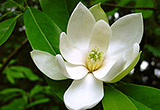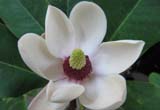A Brief Taxonomic History of Magnolia
Here you will find the current accepted classification of Magnolia prepared by the Magnolia Society's Scientific Advisor Dick Figlar. For more details on each of the species listed in the classification, please consult the Kew World Checklist of Selected Plant Families, for which several Magnolia Society members serve as peer reviewers.
Except for the very distinct genus Liriodendron, taxonomists have long debated the classification of the other lineages comprising Magnoliaceae, known as subfamily Magnolioideae. However, with the advance of molecular systematics (DNA sequencing) beginning in the early 1990’s (Qiu et al, 1995a,1995b Azuma et al. 1999, 2001; Kim et al. 2001, Nie et al. 2008 and others), as well as careful morphological research and observations of living plants (Figlar, 2000, 2002a, 2002b; Sima et al., 2001, Baranova & Jeffrey, 2000; Nooteboom, 1985, 1998, 2000; Li and Conran 2003; Figlar & Nooteboom, 2004), it became clear that Magnolioideae is best described to contain just one genus, Magnolia.
Up until the latter part of the last century, there had been widespread support for the 11 genera treatment for Magnolioideae, devised by the famous Magnoliaceae taxonomist, James E. Dandy of the British Museum of Natural History. In 1927 he codified his system of Magnolioideae as consisting of Magnolia, Manglietia, Michelia, and Talauma, along with several minor genera; Aromadendron, Kmeria, Pachylarnax, Alcimandra, and Elmerrillia (later he recognized Paramichelia and Tsoongiodendron as well).
Dandy based this classification on his own morphological observations and the observations of some of the taxonomists that preceded him: More than 2 seeds or ovules (usually 4) per fruiting carpel representing Manglietia; axillary flower position and stipitate gynoecium for Michelia; and on woody fruits whose carpels fall apart rather than split to release seeds in Talauma, whereas he defined Magnolia by its 1 or 2 seeds (ovules) per carpel, terminal flowers & sessile gynoecium, and carpels that split longitudinally to release seeds. He justified the minor genera based mostly on different combinations of characters that he had defined for the 4 major genera, i.e. Elmerrillia is like Michelia except for its sessile gynoecium, and Paramichelia is similar to Michelia except for its woody Talauma-like fruits, etc.
He also maintained separation of the two (now three) species with unisexual flowers as genus Kmeria. Dandy’s system, which had gradually grown to 11 genera, of which Magnolia was the largest and consisted of 11 sections, was widely accepted for the next 50 years or more (Dandy 1974). Later, noted Chinese Magnoliaceae taxonomist, Liu Yu-Hu (Law Yu-Wu), made minor modifications (added four additional genera) to Dandy’s system in 1984 and in subsequent years. Dandy’s system (modified by Liu) was still followed in Magnolias of China (Liu et al., 2004).
Meanwhile after an extensive study, Hans P. Nooteboom (1985) concluded that Dandy had been misled by “tricks of nature” (i.e. homoplasies) especially regarding fruit characters. Based on this he reduced Talauma and 4 minor genera to Magnolia, and 2 other minor genera to Michelia. Thus, for the rest of the century Nooteboom's new system for Magnolioideae, which then consisted of just 6 genera — Magnolia, Manglietia, Michelia, Elmerrillia, Kmeria, and Pachylarnax — was widely followed throughout the world except in China where Liu's system predominated.
The arrival of DNA sequencing in the early 1990s, quickly provided a new and powerful tool for taxonomic appraisal in plant systematics. By comparing the alignments of DNA sequences, researchers were then able to construct molecular phylogenies – relationship trees – which depict and quantify the evolutionary relationships between the selected taxa. This phylogenetic approach to systematics has gained wide acceptance over the years (Judd et al. 2008), including the underlying assumption that plant classifications should reflect groups that are monophyletic – that is, those containing any and all the descendants of the hypothesized common ancestor of the group.
Phylogenetic reconstructions (trees) resulting from these studies of Magnolioideae consistently showed Manglietia, Michelia and the 3 remaining minor genera to be nested among – not separated from – the various sections of Magnolia. Not only is Michelia nested among the sections, but it resides within the same clade as Magnolia section Maingola (Kim et al. 2001, Azuma et al. 2001). In addition, the studies confirm that Michelia is closely allied to Magnolia subgenus Yulania. Similarly, Manglietia is positioned close to Magnolia sections Oyama and Rhytidospermum. Based on these molecular findings along with supporting morphological evidence, Figlar and Nooteboom (2004) erected a new classification for subfamily Magnolioideae consisting of a single genus, Magnolia, with the 13 or so constituent clades being accounted for in lower ranks (sections and subsections).
Since rank does not affect monophyly in a classification, Figlar and Nooteboom could have just as easily proposed 13 genera to represent Magnolioideae. That alternative was rejected mainly because of (1) the very low sequence divergence (0.63%) between the clades, with some clades even difficult to distinguish morphologically; and (2) nomenclature stability is maximized using a monogeneric system. In a one genus system only Manglietia, Michelia and 3 minor genera require new names in Magnolia. In a 13 genera system, it would be necessary to dismantle the largest and most well-known genus, Magnolia, and rename the constituents into 10 new genera. That would be enormously destructive to the long-established Magnolia-centric nomenclature and literature, causing unnecessary and undesirable consequences to science, conservation and horticulture (Figlar, 2009; 2012).
Classification for Magnolioideae (follows Figlar and Nooteboom, 2004)
Genus Magnolia
Subgenus Magnolia
Branches normally produced by syllepsis (except in subsect. Oyama)
Leaf vernation (prefoliation) conduplicate
Flowers terminal.
Introrse anther dehiscence
Gynoecium sessile
Fruit more/less ovoid or ellipsoid with fused carpels until dehiscence
Mid-late season flowering in non-tropical spp. (Generally, one cannot discern the presence of flower buds until the season in which the flowers are produced.)
Pollen large, diameter usually > 50 µm.
Stamens caducous during male phase (except in subsect. Oyama).Section Magnolia
Leaves evergreen or sometimes facultatively deciduous in one sp., M. virginiana.
Stipules adnate to most of the petiole in one sp., M. virginiana, or adnate to the base of the petiole, thus appearing to be free in all other spp. of this section.
Usually two ovules per carpel.
Stomata group number 5 (see Baranova & Jeffrey, 2000).Section Gwillimia
Leaves evergreen.
Stipules adnate to the petiole.
Usually 2 ovules per carpel.
Stomata group number 9.Subsection Gwillimia
Stipules adnate to (mostly) the entire length of the petiole.
Carpels longitudinally dehiscent.
Stylar beaks, in fruit, often flattened.Subsection Blumiana
Stipules adnate to 50% to 100% the length of the petiole.
Carpels dehiscing mostly circumscissile.Section Talauma
Leaves evergreen.
Long connective appendage (embedded in the gynoecium) except in subsect. Talauma.
Carpels dehiscing circumscissile except in subsect. Cubenses.
Stomata group numbers 5,3, and 2.Subsection Talauma
Stipules adnate to the petiole.
Carpels dehiscing circumscissile
Stomata group number 5.Subsection Dugandiodendron
Stipules free (or appearing so) from the petiole.
Long connective appendage embedded in gynoecium (except in M. calophyllum, M. magnifolium and M. calimaense).
Carpels dehiscing circumscissile.
Stomata group numbers 2 and 3.Subsection Cubenses
Stipules free (or appearing so) from the petiole.
Long connective appendage embedded in gynoecium
Carpels longitudinally dehiscent.
Stomata group number 2.Section Manglietia
Leaves evergreen (except in one sp., M. decidua)
Early season leaves sometimes arranged in false whorls (flushing).
Usually 4 or more ovules per carpel.
Stomata group number 8.Section Kmeria
Leaves evergreen.
Stipules attached to > 50% of the petiole.
Flowers unisexual.
Usually 2 ovules per carpel.
Stomata group number 11.Section Rytidospermum
Leaves deciduous
Branches produced by syllepsis or prolepsis.
Usually 2 ovules per carpel.
Stomata group number 7.Subsection Rytidospermum
Branches produced mostly by syllepsis.
Early-season leaves arranged in false whorls (flushing).
Stamens caduceus during male phase.Subsection Oyama
Branches produced mostly by prolepsis.
Leaves arranged “normally’ (no flushing).
Stamens mostly persistent during male phase.Section Auriculata
Leaves deciduous witrh auriculate bases (glabrous).
Early season leaves arranged in false whorls (flushing).
Flowers semi-precocious.
Tepals without purple spot on base of adaxial surface.
Stomata group number 6.Section Macrophylla
Leaves deciduous with cordate to auriculate bases (glaucous to m/l pubescent).
Early season leaves only moderately flushed.
Tepals with purple spot on base of adaxial surface.
Stomata group number 4.Subgenus Yulania
Branches normally produced by prolepsis (less pronounced in tropical spp.)
Leaf vernation (prefoliation) conduplicate
Flowers terminal and/or on proleptic brachyblasts.
Introrse or latrorse anther dehiscence.
Gynoecium sessile or stipitate.
Fruit more/less cylindrical in shape, often apocarpus, longitudinally dehiscent, or occasionally with lignified carpels resulting in a more ellipsoidal shape which is dehiscent circumscissile.
Precocious flowering, generally before new leaves appear (Usually, one can discern the presence of flower buds during the summer preceding the year the flowers are produced.)
Pollen small, diameter usually < 50 µm.
Stamens persistent during male phase.Section Yulania
Leaves deciduous.
Flowers terminal or sometimes on proleptic brachyblasts.
Latrorse anther dehiscence.
Fruits cylindrical (not apocarpus).
Usually 2 ovules per carpel.
Stomata group number 13.Subsection Yulania
Tepals white, pink, or purple (sometimes outer whorl sepaloid)
Fruits cylindrical.
Pronounced precocious flowering.Subsection Tulipastrum
Tepals green to yellow (outer whorl sepaloid).
Precocious flowering less pronounced.Section Michelia
Leaves evergreen.
Usually 2 to 6 (to many) ovules per carpel.Subsection Michelia
Flowers mostly on proleptic brachyblasts, rarely terminal on long shoots.
Gynoecium stipitate.
Latrorse anther dehiscence.
Fruits cylindrical / apocarpus or occasionally ellipsoidal syncarpus.
Usually 2 to 6 (to many) ovules per carpel.
Stomata group number 12.Subsection Elmerrillia
Flowers mostly on proleptic brachyblasts, rarely terminal on long shoots
Gynoecium sessile.
Introrse anther dehiscence.
Fruits cylindrical but not apocarpus, or occasionally ellipsoidal syncarpus/circumscissile.
Usually 2 to 6 ovules per carpel.
Stomata group number 12.Subsection Maingola
Flowers terminal (on long shoots) or rarely on proleptic brachyblasts.
Gynoecium variably stipitate.
Introrse anther dehiscence.
Fruits cylindrical (not apocarpus).
Usually 2 ovules per carpel.
Stomata group numbers 12 & 14.Subsection Aromadendron
Flowers terminal (on long shoots) or rarely on proleptic brachyblasts.
Gynoecium stipate except in M. ashtonii.
Introrse anther dehiscence.
Fruits with thick connate mesocarp, superficially ovoid/ellipsoid, dehiscent circumscissile.
Stomata group number 14.Subgenus Gynopodium
Leaves evergreen.
Branches normally produced by syllepsis.
Leaf vernation (prefoliation) open, not conduplicate.
Plants entirely glabrous.
Flowers bisexual or tree androdioecious.
Fruit more/less ovoid or ellipsoid with fused carpels until dehiscence.
Carpels dehiscing longitudinally.
Mostly 2 to sometimes 8 ovules per carpel.
Gynoecium shortly stipitate (sessile in M. praecalva & M. pleiocarpa)Section Gynopodium
Tree androdioecious (or probably bisexual in M. nitida var. nitida & M. kachirachirai)
Gynoecium shortly stipitate.
Carpels dehiscing mostly along dorsal suture.
Ovules 2 per carpel (up to 4 in M. kachirachirai)
Stomata group number 11.Section Manglietiastrum
Flowers bisexual.
Gynoecium sessile (but shortly stipitate in M. sinica)
Carpels dehiscent mostly along the ventral suture especially at apex of fruit.
Usually 3 to 8 ovules per carpel.
Stomata group number 10.Azuma, H. et al. (1999). Molecular phylogeny of Magnolia (Magnoliaceae) inferred from cpDNA sequences and evolutionary divergence of floral scents. Journal of Plant Research 112: 291-306.
Azuma, H. et al. (2001). Molecular Phylogeny of Magnoliaceae: The Biogeography of Tropical and Temperate Disjunctions. Am. J. Bot. 88(12): 2275-2285.
Baranova, M. A. & C. Jeffrey (2000). Stomatographical Features in the Systematics of the Magnoliaceae. Bot. Zhurn. 85: 35-49.
Dandy, J. E. (1927). The Genera of Magnoliaceae. Kew Bulletin: 257-264.
Dandy, J. E. (1974). Magnoliaceae in Praglovski. In: S. Nilsson, World Pollen Spore Flora 3.
Figlar, R. B. (2000). Proleptic branch initiation in Michelia and Magnolia subgenus Yulania provides basis for combinations in subfamily Magnolioideae. In: Liu Yu-hu et al., Proceedings of the International Symposium on the Family Magnoliaceae: 14-25, Science Press, Beijing.
Figlar, R. B. (2002a). Those amazing Magnolia fruits. Magnolia – J. Mag. Soc. 37: 7-15.
Figlar, R. B. (2002b). Phyllotaxis in Magnolia fruits. Magnolia – J. Mag. Soc. 37: 26-28.
Figlar, R. B. (2009). The sinking of Michelia and Manglietia into Magnolia. The Plantsman n.s. 8(2): 118-123.
Figlar, R. B. (2012). Turning Points in the Taxonomic History of Magnolioideae – from Baillon to Dandy to DNA. In Xia Nian-He et al., Proceedings of the Second International Symposium on the Family Magnoliaceae: 47-54.
Figlar & Nooteboom (2004). Notes on Magnoliaceae IV. Blumea 49: 87-100.
Imkhanitskaya, N.N. (1991). Genus Magnolia (Magnoliaceae) in Flora Cubae, in Novosti Sist. V ssh. Rast., 28: 60 [re: Subsect. Cubenses].
Kim et al. (2001). Phylogenetic relationships in family Magnoliaceae inferred from ndhF sequences. Am. J. Bot. 88(4): 717-728.
Kumar, V.S. (2006). New combinations and new names in Asian Magnoliaceae. Kew Bulletin 61: 183-186.
Law, Y. W., (1984). A preliminary study on the taxonomy of the family Magnoliaceae. Acta Phytotaxonomica Sinica 22: 80-89.
Li, J. and J. G. Conran (2003). Phylogenetic relationships in Magnoliaceae subfam. Magnolioideae: a morphological cladistic analysis. Plant Syst. Evol. 242:33-47.
Liu Yu-Hu et al. (2004). Magnolias of China. Baitong Group, Beijing Science and Technology Press. Beijing.
Nie, Z.L., J. Wen, H. Azuma, Y.L. Qiu, H. Sun, Y. Meng, W.B. Sun, and E.A. Zimmer (2008). Phylogenetic and biogeographic complexity of Magnoliaceae in the Northern Hemisphere inferred from three nuclear data sets. Molecular Phylogenetics and Evolution 48: 1027-1040.
Nooteboom, H. P. (1985). Notes on Magnoliaceae, with a revision of Pachylarnax and Elmerrillia and the Malesian species of Manglietia and Michelia. Blumea 31: 65-121.
Nooteboom, H. P. (1998). The tropical Magnoliaceae and their classification. In: Magnolias and their Allies, proceedings of an international symposium.
Nooteboom, H. P. (2000). Different looks at the Classification of Magnoliaceae. In: Liu Yu-hu et al., Proceedings of the International Symposium on the Family Magnoliaceae: 26-37, Science Press, Beijing.
Qiu et al. (1995a). A chloroplast DNA phylogenic study of the eastern Asia – eastern North America disjunct section Rytidospermum of Magnolia (Magnoliaceae). Amer. J. Bot. 82: 1582-1588.
Qiu et al. (1995b). Molecular divergence in the eastern Asian – eastern North America disjunct section Rytidospermum of Magnolia (Magnoliaceae). Amer. J. Bot. 82: 1589-1598.
Sima, Y. K. et al. (2001). Prefoliation Features of the Magnoliaceae and their Systematic Significance. Journal of Yunnan University 23: 71-78.



